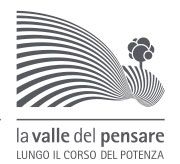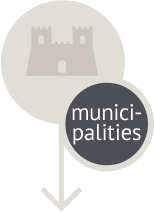The Accademia Georgica is located in a prestigious XIX century building designed by the architect Giuseppe Valadier, that stands out in the main square.
The Accademia Georgica had its most fruitful period between the late XVIII and the early XIX century, when the Enlightenment ideas reached the Marches even before the Napoleonic Army.
The population growth of that period caused a deep economic crisis throughout Europe. Effective solutions could be found in progress and the development of agriculture.
These needs found fertile ground in Treia, where some innovative intellectuals, dedicated to agronomy turned the "Accademia dei Sollevati" (XV century) into a research and agricultural research centre and renamed it "Accademia Georgica dei Sollevati". Among the members of the Accademia, the brothers Fortunato and Callisto Benigni distinguished themselves.
The Accademia of Treia grew prominent in few time and managed to establish a contact with the "Accademia dei Georgofili" in Florence, whose close relationship has come to our days.
Researches and experimentations were the principal objective to be pursued by the Accademia Georgica. Studies and experimentations were published in the “Journal of Guilds and Commerce”, edited by the Accademia in 1780 and 1781 and released not only in Italy, but also in Europe. The agricultural sector was highly marked by its researchers’ commitment. Cultivation of hemp and flax, extraction of sunflower and grapeseed oil, introduction of potatoes in the countryside of the Marches, import of forages such as alfalfa, ryegrass, cabbage and turnip that were still unknown by farmers at that time, cultivation of tobacco, search for new seeds, crop rotation and beekeeping must be remembered. The scholars of the Accademia supported also biological techniques, protecting the environment and the crops from the pests. In 1781, during the brief pontificate of Pious VI, the Academicians were authorized to found a “House of Correction and Labor”, where the misfit, wandering, unemployed young people manufactured canvas, laces, nets and fabrics for sail manufacture were produced. In 1799 the Academicians from Treia started to study meteorology and the lunar influences so to know the effects of climate change on human beings and crops. The Accademia has a precious book collection of 14,000 volumes, a rich archival heritage, including the “historical town archive” and the “diplomatic-pergameneous fund”. As for the second, it features 1,196 parchments, whose oldest dates back to 1161 and it deals with the sale of San Lorenzo Castle. Instead, the most original for its overall length of 11.98 meters concerns the trial of Podestà Baglioni between 1278 and 1296. Part of the heritage of the Accademia are also: the Academicians’ Archive comprising manuscripts about agrarian studies; incunabula; codes; dies; seals; the collection of photos with autographs and dedication by celebrities, given by Raffaele Simboli; pictures by the futurist painter Giacomo Balla; portraits of personalities like Bartolomeo Vignati; Giulio Acquaticci; Ilario Altobelli; Luigi Lanzi; Fortunato Benigni; the Filippini Fathers’ and the Clarisses’archive funds; the Oliviero Montebello’s music archive ; papers about the Town Theater and the town Band. Even today, the Accademia contributes to the cultural development of the region and stands as the reference point for scholars and researchers. The Academic Magistrate’s commitment over these recent years aims to provide the community with an ever functional service to meet new requirements.
Among the ongoing projects we report, in particular, the activity of digitization of the ancient library by scanning n. 9560 volumes and the project of reclamation, restoration and cataloging of the Municipal Historical Archive from its origins to 1970.
“Tra quadri grandi e piccoli, il suo autoritratto: grandezza naturale, colori, mezzo busto, tre quarti, giovane prete; collarino bianco tra il bruno ramato della faccia e il nero della veste. Spiegava che se l'era fatto guardandosi allo specchio. Ora è la cosa più cara che io abbia; a quel ritratto io parlo. Nel tempo che fummo insieme il paese lui lo percorreva per due sole mete: la cattedrale e l'Accademia Georgica. Se amasse la cattedrale non so, che fosse attaccatissimo alla Georgica, ne sono sicura. Quando ci dovremo dividere, l'autoritratto andrà a quell'Accademia. Sarà meno solo di me».
Da “Giù la piazza non c’è nessuno” di Dolores Prato
FORTUNATO BENIGNI
Treia, 1756 – 1831
Poet and man of learning, Benigni is the model and the archetype of the intellectual patriot of the Marche, cult member of his homeland. Thanks to him, the ancient roman name of his city, Treia, has been renovated from the roman municipal hall Trea, that until 1790 it named Montecchio. He was an author of publications about history, monuments and ruins of the Roman Trea and, furthermore, he was promoter and creator of scientific turning point in the Accademia dei Sollevati. He transformed it in an European centre of avant-garde for agricultural studies given it the name of Accademia Georgica. He was also the author of “Giornale delle Arti e del Commercio” published in Macerata in 1780.
PAPA PIO VI
With the seal “Emixum animi nostri stadium” of 1790 confers to Treia the title of City and a new name, exactly Treia. To him was dedicated, in 1785, the monument in the square in front of the Municipal Palace, for the opening of “Pie Case di Correzione e Lavoro”.
LUIGI LANZI
Treia, 1732 - Firenze, 1810
Historian of art, archeologist, philologist and Jesuit. It was nominated by the Granduca Pietro Leopoldo as antique dealer of Regia Galleria of Firenze. It is an author of works about archeology and Paleolithic philology; his main work is “la Storia pittorica d'Italia”, the first critical history of Italian art. He is buried at Santa Croce in Firenze among the great of the homeland. Few people know that Lanzi is the creator of the actual selection and the outfitting of Uffizi in Firenze.
ILARIO ALTOBELLI
Treia, 1560 - 1637
Astronomer, minor, he was a contemporary and friend of Galilei, contributed, despite the clothing, to the support of his scientific thesis. He discovered the Saturn satellites and he observed, among the first, the “Nova” star, that created many discussions between the astronomers of his time, showing in the De nova stella of 1628. He developed an acclaimed system for orthographic perspective of welkin. From 1604, he was a math and astronomy teacher at Verona University. Well-known his Tabulae regiae astromicae of 1628. One of his portrait is conserved near the Accademia Georgica.
NICOLO’ GRIMALDI
Treia, 1768 - Roma 1845
Cardinal, he had important roles with Pio VII, Leone XII, Pio VIII and Gregorio XVI, whom named him Governor of Forlì.
AGEO ARCANGELI
Treia, 1880 - Roma 1935
Jurist, he was one of the main expert of commercial law. After the studies in Macerata, he taught in Urbino, Camerino, Perugia, Sassari, Macerata, Parma and Bologna, finally in Rome from 1930. Together with Alfredo Rocco (father of penal code), he was among the most famous jurists that adhere to Fascism, occupying of the agricultural law and policy of the regime.
Contacts and Informations
Accademia Georgica
Piazza della Repubblica, 13
62010 Treia (MC)
Telephone and Fax 0733.215056
Web site: www.accademiageorgica.it
E-mail: info@accademiageorgica.it










